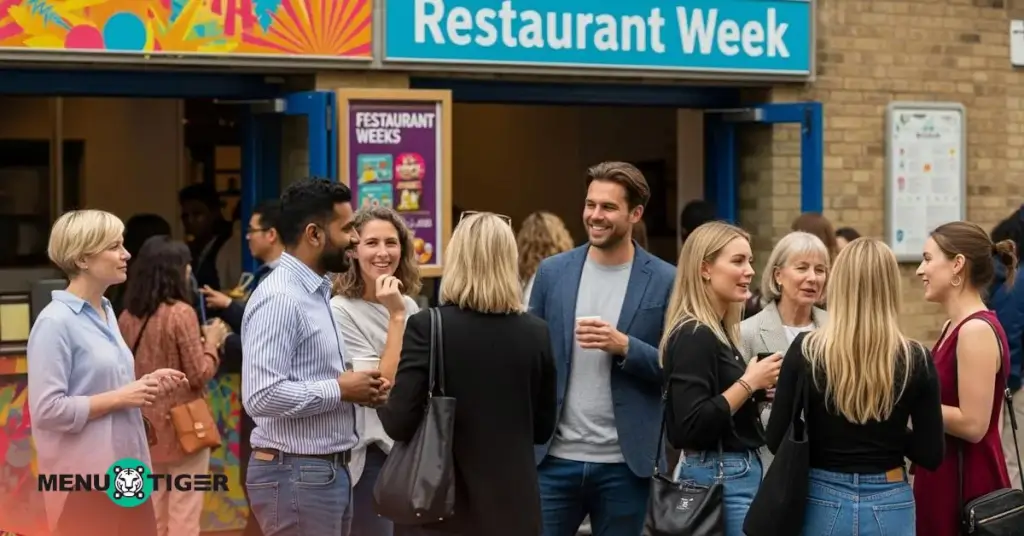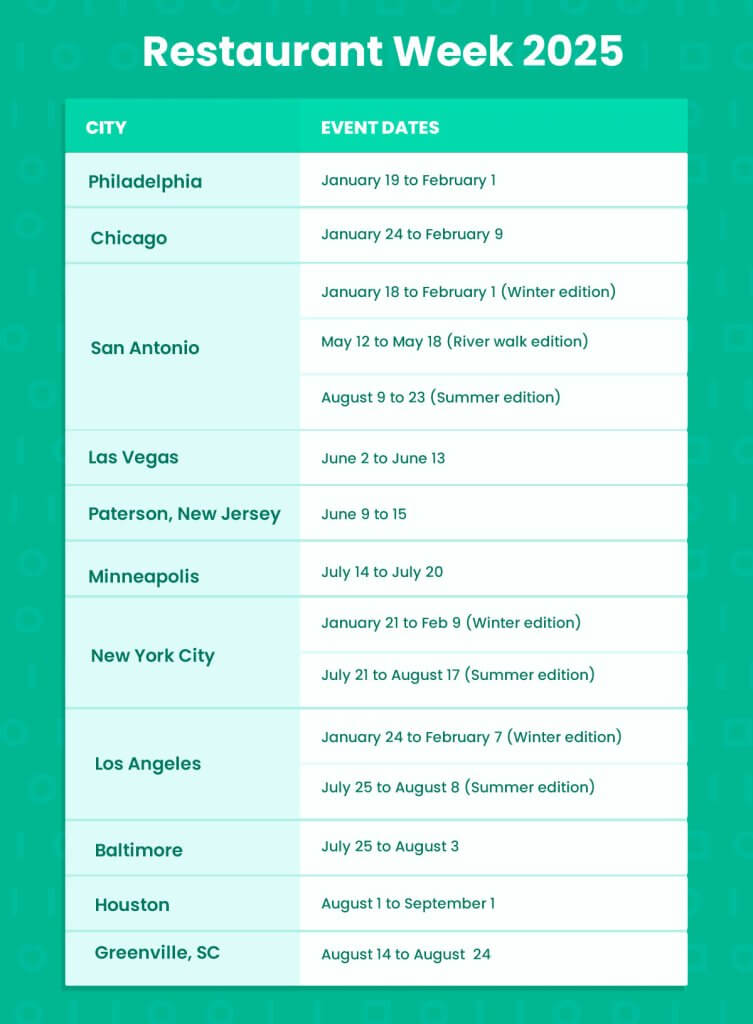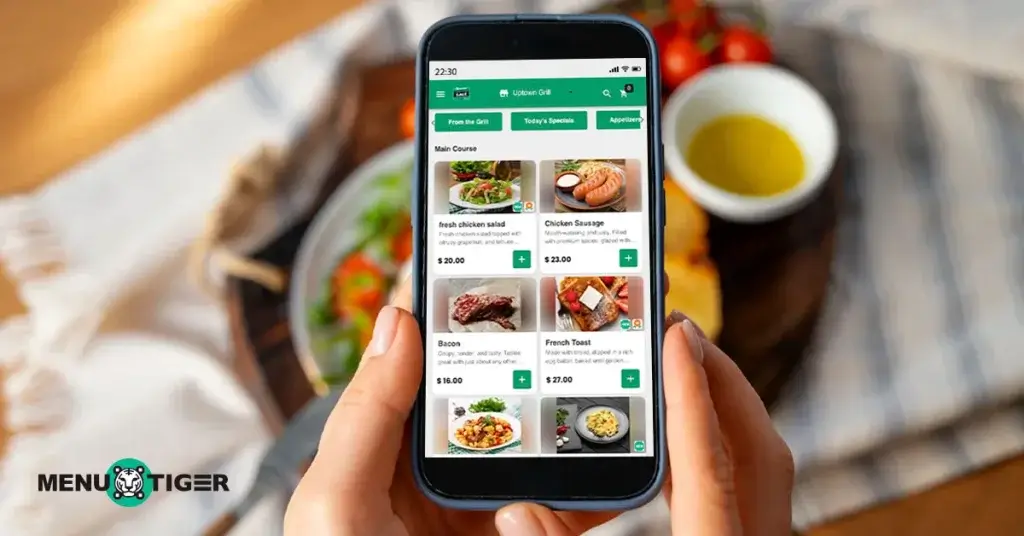
Restaurant Week 2025: Stand Out or Stay Empty
Last Updated: July 31, 2025
Think you’re ready for Restaurant Week? Think bigger. In this event, being unforgettable is what gets you chosen. And when done right, participating can be your biggest flex.
First things first: check if your city is one of the key participants. If it is, don’t just sit back and watch others take the spotlight. And if it’s not? Don’t be the last to bring the buzz. Be the first to set the trend in your area.
So, lock in your concept, update your menu, and make sure your order management system is ready to handle the rush.
But the real question is: Will it deliver an experience worth remembering? Let’s dive into the details.
What is restaurant week?
This event isn’t deeply rooted in cultural or traditional origins. Instead, it’s a culinary promotional event with relevance tied to economic impact and community engagement.
The main objective is to boost foot traffic and introduce people to both local favorites and new restaurants, especially after seasonal lulls and post-holiday slowdowns.
During the event, each participating restaurant offers a prix fixe menu (fixed price), which could be a three-course meal priced around $50 per person, though this is just an example and may vary.
How it started and why it exists
This promotional event began in New York City in 1992, created by Tim Zagat (the founder of the Zagat Survey) and Joe Baum (a prominent NYC restaurateur) as a one-time promotion during the Democratic National Convention.
The idea was simple: offer fixed-price lunches at top restaurants to attract journalists, delegates, and tourists. It's a concept that works well for fast-casual restaurants setups, fine dining establishments, and modern spots.
As reported by amNY, a free NYC news outlet, the idea was so well-received that even former Mayor David Dinkins, who helped launch the event with industry leaders like Tim Zagat, once said, “I’m not surprised it’s lasted this long.”
Today, it has grown into a key event that boosts the local dining economy, raises restaurant visibility, and encourages diners to discover new dining experiences.
Mark your calendar: when it’s happening in 2025
This event isn’t anchored to a fixed calendar date like traditional holidays. Instead, it acts more like a localized restaurant appreciation week, intended to boost foot traffic, spotlight local dining, and strengthen community ties.
It's scheduled independently by each city; some might celebrate it once, twice, or thrice a year, with dates and formats varying based on local organizers, and one example is Restaurant Week NYC.
Below are the confirmed 2025 dates for U.S. cities that have publicly released their schedules, based on reliable sources:

Updated as of July 2025. Some events may have passed but are listed for reference and planning purposes. You can use these dates to anticipate 2026 timelines or analyze how earlier events performed.
How does this promotional event work today?
If you want to join the event, you usually need to:
1. Register
Register with the official event organizers through a website or platforms, which could be the city’s tourism department, a restaurant association, or a third-party event management group.
Once approved, your restaurant will be added to the official event listing, where diners can browse and book directly.
To stay in the loop, subscribe to your local tourism board’s newsletter or follow them on social media. They usually announce when sign-ups open.
2. Create a special prix fixe menu
Typically, the prix fixe menu includes three courses: an appetizer, main course, and dessert, and should be different from your regular offerings. You’ll need to create this menu in advance, as organizers will ask for it when you register.
3. Set pricing
This event has standard price tiers in line with event guidelines, which helps keep things consistent for diners.
Check previous information or ask organizers for the current pricing structure; they often provide a breakdown or template you can follow.
4. Prepare for higher traffic
Since the event draws in new and returning guests. This often means training staff, streamlining service, and promoting the event on their channels.
Also, using a menu management system like a QR code for restaurants helps speed up ordering, reduce wait times, and keep service smooth during the rush.
5. Follow branding or marketing requirements
If you’re promoting your participation online, make sure to use the official hashtags, campaign slogans, or tags provided. Some events also require you to display signage at your restaurant or include branding in your menu layout.

Is participating worth it?
The answer is yes, if done smartly. This isn’t about sugarcoating the challenges. The event demands preparation, precision, and tight cost control. But when approached strategically, it can be a valuable opportunity.
Here’s why it is worth it:
1. Built-in marketing at no extra cost
Organizers typically promote participating restaurants across city websites, social media, and local press. The event might cost a specific amount of participation fee, but that's visibility many small restaurants can’t afford year-round.
2. Guest data access (if applicable)
During this event, some organizers share opt-in diner information or feedback, giving restaurants the chance to follow up through restaurant newsletters or with targeted promotional offers.
If that’s not available, consider using a digital menu ordering system. It provides customers with a website where they can log in, allowing you to gather insights and promote daily specials or featured dishes on regular days.
3. Opportunity to fix pain points quietly
A rush of service volume can reveal cracks in restaurant order systems in place, plating speed, or communication. With this, you can schedule a quick debrief after each night to identify and tweak what’s not working while it's still fresh.
4. Research and development in disguise
This is where you can slip in one “experimental” item that you’ve considered for your next menu, then track which dishes diners ask about after the event.
Offering a creative set menu allows you to trial new dishes and gauge guest response before officially adding them.
5. Local PR leverage
This event is often covered by local food journalists and bloggers. Just being part of the event list can get your name into their articles or social posts.
It puts your business in the spotlight while people are actively searching for places to try.
6. Improves your online ratings

This is where the challenge comes in: joining the event will bring in a surge of customer feedback. That’s a good thing, but only if you’re well-prepared to deliver a great experience.
Being consistent in delivering a smooth order management and memorable experiential dining often results in more positive reviews.
7. Opens doors for future partnerships
Whether it’s beverage brands, delivery platforms, or tourism boards, visibility during the event puts your name on more radars.
Save media coverage or high-performing posts; they’re great proof when pitching future collaborations.
8. Strengthens supplier relationships
A surge in demand gives you a reason to negotiate better short-term rates or test new supplier products. So, let your trusted vendors know in advance. Some might throw in free samples, discounts, or even cross-promotion.
How to make your restaurant the top pick for diners

Make this year’s event your busiest, smoothest, and most profitable yet. Serve big and savor every moment with these winning ideas:
1. Build anticipation like it's an album drop
Forget soft launches. Tease your menu like it’s your biggest release of the year. Post early snippets on your website, send email teasers to your regulars, and start building buzz through social media for restaurants to drive early interest and reservations.
Make it feel exclusive, like they are getting early access to something buzzworthy. It is about energy, not just information.
2. Share restaurant deals of the week
Your special menu should highlight what your kitchen does best and your restaurant specials this week. Creating a secret menu can also be a clever way to showcase what your kitchen does best.
Use ingredients that can be cross-utilized to stay efficient, but make sure at least one item sparks a reaction. People will share what surprises them, not what they expect.
3. Launch a “dine and win” promo for the week
Give your guests a reason to engage beyond the plate. You can suggest a future wine pairing experience or a special event night cross selling or raffle off a private dinner, branded merch, or free drinks for their next visit.
All it takes is a simple entry form or scan-to-join option. It builds your contact list while giving them something to look forward to.
4. Cross-promote with nearby businesses
Partner with a florist, gallery, or coffee shop nearby. Maybe guests get 10% off dessert if they show a receipt from your partner. It builds community goodwill and gives customers more reason to choose your location over others.
5. Add a cause or purpose to the week
Tie your participation to a cause, like donating a portion of proceeds to a food bank or community kitchen.
Guests feel better about their spending when it supports a purpose beyond profit, serving as a form of financing for something meaningful.
6. Slip in subtle upsells
Even with a fixed price, there is room to increase revenue without being pushy. Offer wine pairings, featured cocktails, or a signature dessert that is not part of the main package.
Train your staff to suggest these extras in a way that feels thoughtful and personalized. Guests are more likely to say yes when it feels like a genuine recommendation.
7. Use a scent memory trigger
If your signature dish has a distinct smell of herbs, spices, or grill smoke, lean into it. Let them be reminded of the experience in your restaurant every time they smell a specific scent.
Open the kitchen, let the aroma spill into the space, or infuse a custom candle for bathroom or front desk areas. The scent is powerful and sticks with guests long after the meal.
8. Offer a “last day surprise” twist
On the final day, surprise diners with a complimentary treat, extra course, or upgraded version of menu items. This unexpected gesture will make them feel lucky for showing up and likely to talk about it afterward.
9. Offer seamless service using an online menu ordering system

Staff will be extra busy during this event, so don’t settle for a menu that just sits there; use one that steps up and helps out during the busy hours.
Look for an online menu ordering system that offers easy-to-update digital menus, QR code access for quick and contactless ordering, mobile-friendly navigation, support for mobile payment integration, and more.
Make every course count and every visit memorable!
If you’re participating in restaurant week, understand this: the real opportunity isn’t the spike in bookings; it’s the strategic value of being seen, tested, and remembered.
Every plate you send out is a message. Every guest you serve is a potential advocate or a missed connection.
So step up with intention, lead with creativity, and treat this moment not as a rush to survive, but a chance to define your restaurant’s next chapter.



